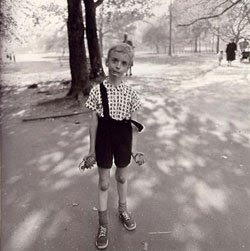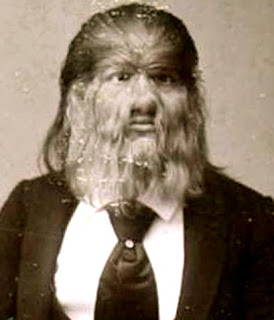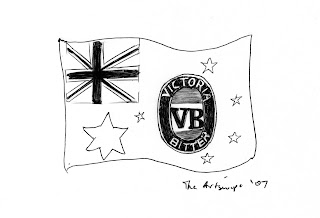
Nicole Kidman and Ty Burrell in Fur: An Imaginary Portrait of Diane Arbus
Recently I did myself an art favour and saw Fur: An Imaginary Portrait of Diane Arbus. When you can't be fucked walking through a museum, an art biopic can really go a long way in providing some aesthetic nourishment. And yeah, that's the kind of meat and potatoes one needs to grow big and strong amidst the beige tones.
I remember a bit about Diane Arbus from art school - she was, like, one of those crazy art ladies who suffered, probably from her own eccentricity bottled as genius and marketed by art dealers as the "real deal". Maybe her work pushed the pioneering envelope in a world where women might not paint or sculpt (or at least they didn't get credit for it). But women seemed particularly suited to photography because pushing the button on one of those camera device thingies can really help reinforce off-kilter freak-fetishism. A sense of rarified otherness. Women do photography well because, well, as an overly democratised medium - readily accessible to the masses during the rise of twentieth century consumer cultures patented by monopoly magnet Kodak and good for promoting the ideology of the "say cheese" smile - photography was seen to be better suited to women than more serious art pursuits like painting or sculpture. During modernity mass culture was feminised by Marxist theorists like Andreas Huyssen simply because of its very reproducibility. And nothing connotes reproducibility more than the seemingly disparate entities of women and photography.
Maybe I just wandered off the point, who knows. As it turned out Fur was so boring - and not really a biopic in the traditional sense - that one couldn't help wandering off into some theoretical reverie. The opening credit sequence elegantly establishes how the film ultimately privileges style over substance, and hey that's fine - I can be as shallow as the next person. Steven Shainberg, whose previous film was the overhyped Maggie Gyllenhaal vehicle Secretary, imbues Fur with such self-conscious silences to build mystery, tension and suspense that it feels like a pop-up book; it was that motionless, not to mention stark in its technicolour three-dimensionality. I may not know or remember much about Diane Arbus (I was surprised to learn here that her Christian name is pronounced Dee-anne) but I do recall the visceral, high octane power of her imagery: that one photograph (not in the film) of a freaky kid holding a hand grenade in Central Park gives me nightmares whenever I fall asleep in public places. (My psychiatrist calls this kind of thing "pre-terrorism-era-tension" in a journal article she published on this very phenomena). Arbus knew how to solidify and mould oddness into a shape that may belie description, but could still speak volumes - even if she repeatedly exoticised the freakish Other in the process. With Fur, oddness is more a fashion statement like bourgeois ennui is for most contemporary French art films.
I remember a bit about Diane Arbus from art school - she was, like, one of those crazy art ladies who suffered, probably from her own eccentricity bottled as genius and marketed by art dealers as the "real deal". Maybe her work pushed the pioneering envelope in a world where women might not paint or sculpt (or at least they didn't get credit for it). But women seemed particularly suited to photography because pushing the button on one of those camera device thingies can really help reinforce off-kilter freak-fetishism. A sense of rarified otherness. Women do photography well because, well, as an overly democratised medium - readily accessible to the masses during the rise of twentieth century consumer cultures patented by monopoly magnet Kodak and good for promoting the ideology of the "say cheese" smile - photography was seen to be better suited to women than more serious art pursuits like painting or sculpture. During modernity mass culture was feminised by Marxist theorists like Andreas Huyssen simply because of its very reproducibility. And nothing connotes reproducibility more than the seemingly disparate entities of women and photography.
Maybe I just wandered off the point, who knows. As it turned out Fur was so boring - and not really a biopic in the traditional sense - that one couldn't help wandering off into some theoretical reverie. The opening credit sequence elegantly establishes how the film ultimately privileges style over substance, and hey that's fine - I can be as shallow as the next person. Steven Shainberg, whose previous film was the overhyped Maggie Gyllenhaal vehicle Secretary, imbues Fur with such self-conscious silences to build mystery, tension and suspense that it feels like a pop-up book; it was that motionless, not to mention stark in its technicolour three-dimensionality. I may not know or remember much about Diane Arbus (I was surprised to learn here that her Christian name is pronounced Dee-anne) but I do recall the visceral, high octane power of her imagery: that one photograph (not in the film) of a freaky kid holding a hand grenade in Central Park gives me nightmares whenever I fall asleep in public places. (My psychiatrist calls this kind of thing "pre-terrorism-era-tension" in a journal article she published on this very phenomena). Arbus knew how to solidify and mould oddness into a shape that may belie description, but could still speak volumes - even if she repeatedly exoticised the freakish Other in the process. With Fur, oddness is more a fashion statement like bourgeois ennui is for most contemporary French art films.

Diane Arbus
Child with a Toy Hand Grenade in Central Park, 1962
Fur, then, is a conflation of two real-life stories to create some strange hybrid, deconstructed truth. A non-truth to be sure because when master narratives are broken down, nothing survives the carnage, not even truth. If Fur was a novel, it might resemble the kind of postmodern historical fiction Kathy Acker produced; stories that would be populated with divergent historical, literary and popular culture figures. If the filmmakers had been that honest and just said in the press notes: "We want to show what might have happened if Diane Arbus time travelled to 1884 and plucked Jo-Jo from the circus: first for a photo shoot, second for a good roll in the hay, and third for her own morbid self-discovery." But this is an art film and audiences are meant to accept that the bedroom wall of Arbus' psychological space was plastered with posters of freaks like Jo-Jo, which served as inspiration for a body of photographic work which would ultimately render her an iconic American artist of the twentieth century.
Another reason why Fur is simply a prickly exercise in film spectatorship is because Nicole Kidman makes me really uncomfortable, to say the very least. I know it's probably just me who thinks she's the most mediocre actor of her generation - really my opinion is beside the point - but why, GOD WHY does she keep getting all the plum film roles when clearly her idea of acting is embodying her characters like some little reedy wisp of a woman whose idea of 'motivation' is oscillating between a breathy babywoman voice and a stern iciness better suited to glazed donuts than womenfolk. In Fur, Kidman embodies Arbus as much as lice may have Jo-Jo's dog hair - with such an itchy and irritable devotion that I spent most of the film absent-mindedly scratching a phantom itch.
And really, that is what Fur is all about: the scratching of a fetishistic itch. Freud's idea of fetishism was all about the substitution of the part for the whole because of a seemingly deep-seated psychological lack experienced at a young age and attributed to the witnessing of a woman's lack of a penis - the horror or her nothing to see. A fetishistic synecdoche, fur (which, technically speaking, is hair in this film) represents a body part standing in for the whole. But interestingly, Lionel's whole body is entirely covered in hair, making the theory of fetishistic substitution an awkward one. Perhaps then, it's the eyes which are the body part fetishised here? The eyes of the all-seeing photographer who has special visual access to all things bright and beautiful, weird and wicked. In his review of Fur, Village Voice critic J. Hoberman argues, "Kidman acted around a prosthetic proboscis to win an Oscar for her impersonation of Virginia Woolf in The Hours; as Arbus, she's all eyes."
Now I know why Kidman is so popular, so meaningful to casting directors: she makes magic out either her eyes or nose. It's not unsurprising she followed The Hours (2002) some films later with Bewitched (2005). The spell cast by the twitch of her cute little nose in Bewitched erased all memory of the pre niptuck whopper she was packing in The Hours. And if what they say about big noses is correct, it sheds new light on the horror of her nothing to see.

Fedor Jeftichew AKA Jo-Jo the Dog Faced Boy

